공지사항
-
- '노란봉투'캠페인/국제연대..
- no chr.!

While nearly all int'l "important"(i.e. bourgeois, of course..^^) news agencies/TV stations were/are reporting about today's "peace making event" (CNN/World News Asia) at the DMZ, A. Vershbow, the US ambassador in Seoul (i.e. the Bush administration) yesterday warned the SK government "that the United States wants Seoul not to speed up the inter-Korean reconciliation".
Yo, you f.. idiot, shut up! That's not your business!!!
Hankyoreh wrote today about it following:
☞ On inter-Korean relations, U.S. officials say, ‘slow down’
And Korea Times:
"U.S. Ambassador to Korea Alexander Vershbow stressed close coordination between Seoul and Washington on inter-Korean reconciliation Wednesday, one day before South and North Korean trains are to cross the Demilitarized Zone (DMZ)..
His remark is widely interpreted here as meaning that the United States wants Seoul not to speed up the inter-Korean reconciliation.."
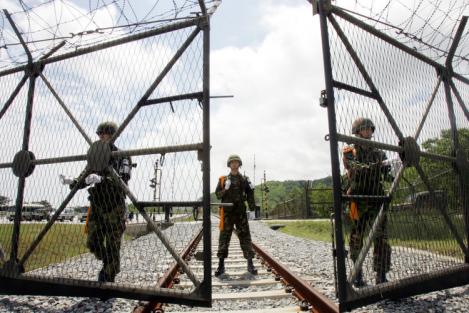
About today's inter-Korean train event CNN, as its THE TOP STORY, wote:
☞ Koreas make tracks towards peace

More about it you can read here:
☞ Trains carry nation's hopes for future (K. Herald)
☞ DMZ train tested, but no ‘All aboard!’ foreseen (JoongAng Ilbo)
☞ Koreas hold historic rail crossing (al-Jazeera)
☞ First Trains in 56 Years Cross Inter-Korean Border (Chosun Ilbo)
☞ Inter-Korean train lines tested, so what now? (Hankyoreh)
☞ In Pyongyang, all is silent regarding train test
☞ "A New Era in North-South Relations" (VoP, incl. video report)
Some - partly nice/interesting - pics about the event you can see here:
☞ First Time in 56 Years, S-N Korea Trains Depart (DailyNK)
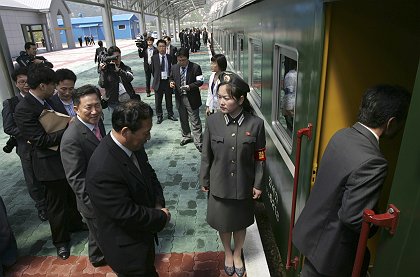
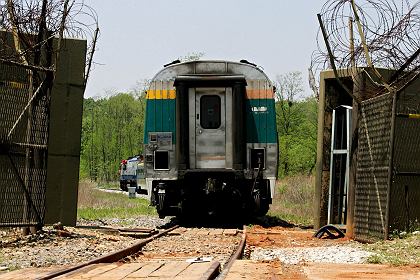

The SK semi-official news agency Yonhap published today following feature:
Rare experience aboard N. Korean train across the border
At the urging of North Korean conductors, 100 South Koreans and 50 North Koreans boarded a five-car train at 11:25 a.m. With no speaker system at Kumgangsan Station at the North's scenic mountain along the east coast, conductors repeated "Please board the train" through a loudspeaker mounted upon a South Korean-made Hyundai Starex utility vehicle.
Painted green on the main body and the roof a faint gray, the facade of the train was far from modern. "The train looks like South Korea's obsolete third-class train, but its ability is better than that," said Lim Jong-il, a South Korean official at the Ministry of Construction and Transportation.
South Korean Construction Minister Lee Yong-sup, Kim Yong-sam, the North's railway minister, and some 20 South and North Korean journalists crowded into the second car of the train. The smell of new paint assailed the nostrils upon ascending the steps, while a pair of portraits of Kim Il-sung and his son Kim Jong-il hung on the wall above the door.
The seating arrangement was face-to-face, and refreshments for passengers were set on a small table in front of the window -- one lemon-lime soda, one strawberry juice, one bottled water, two apples and a pear. North Korean female attendants served a cup of ginseng tea for passengers later.
The upright, ivory-colored vinyl seats were a little bit uncomfortable and did not recline, but the cushions were softer than they appeared to be.
Outside the window, a uniformed North Korean conductor waved a red flag and goose-stepped past the train, which signaled the impending departure. A few North Korean security officers came inside to check the number of passengers and asked journalists jostling for position to sit down.
At 11:27 a.m. a long whistle sounded, reminiscent of an old-time steam locomotive. The train spluttered back and forth several times and then slowly started forward. "North Korean trains usually whistle a lot," a South Korean transportation official said.
North Korean middle school students, who attended a ceremony, started to wave their hands, and South Korean passengers responded in kind. The train moved out of Kumgangsan Station at the speed of 10 kilometers per hour, and North Koreans working nearby just looked at the train without reacting in a friendly manner.
Some 50 meters away from the railway on the right side, a paved road appeared as the scenic Mount Geumgang faded from sight. Rice paddies were waiting for rice seedlings to be planted, but no peasant was seen working outside.
Unexpectedly, well wishers were South Korean tourists traveling to the Mount Geumgang resort in a convoy of eight buses. "At this time of the day tourist buses go to the resort," a South Korean official said.
At 11:30 a.m. the stretch of hills and mountains continued, and the clouds moved quickly against the blue sky, cleansed from the previous day's rain.
A few Toyota jeeps driven by soldiers, military jeeps and trucks drove parallel with the train and then fell behind. North Korean soldiers were stationed at the checkpoints of major intersections.
Then the track turned sharply, a rare occurrence on South Korean track. The sharp turns came again and again, and a woman peeked outside the window at a nearby village.
The overall atmosphere was friendly, a throwback to a picnic in the 1970s-80s on a slow, squeaking train. Hills and mountains passed by, and splendid pine trees of all kinds of shapes. After awhile the Nam River appeared on the right side of the train. At one village, some 10 residents came out and looked over the communal wall to watch the passing train.
At 11:50 a.m. the train passed Samilpo Station. The painted name on the station was very small, like Kumgangsan Station, and an oversized portrait of Kim Il-sung hung on the front of the station, along with pro-communist and cult propaganda slogans.
The train crossed the river on a bridge restored with steel plates provided by South Korea. Outside the window, North Korean tourist attractions such as Haegumgang and Samilpo were seen a little farther away.
At 11:50 a.m. some passengers pushed up the windows, and the unpolluted air coming through the open windows refreshed them. A group of 10 North Korean soldiers stood guarding a storage house of diesel engine trains built for the railway test run. There was no other train in sight.
The train slowed down at Kamho Station, where North Korean customs officials were stationed. It was 11:55 a.m.
Around 12:00 p.m. four customs officials and two conductors boarded each car of the train. One of them shouted, "We fervently welcome you who have become the first passengers of the train! Now we will start customs clearance procedures."
Conductors checked the identities of the passengers and digital cameras. They asked a passenger to delete a photo of portraits of Kim Il-sung and Kim Jong-il that had been blurred from the shaking of the camera.
At 12:15 p.m. the conductors suddenly moved to the exit and disembarked. They must have gotten orders to let it pass, as the inspection took longer than expected. The train started to move again right away.
"Now you will see an outpost about 200 meters. It is the Military Demarcation Line," said Kim Kyong-jung, chief of the inter-Korean railway team at the Ministry of Construction and Transportation.
A sharp whistle blew, and the train picked up speed, double its previous pace. The shaking was palpable, but not enough to affect the bottles on the small table. With the speed increasing, the frequency of the whistle's call also increased.
In five minutes, the train passed the Northern Limit Line and went into the Demilitarized Zone. At 12:21 p.m., it passed the Military Demarcation Line to roars of applause. The train slowed a bit and the passengers became quiet, awaiting arrival.
At 12:25 p.m., a South Korean tourist observatory appeared, and some 200 tourists on the porch waved their hands eagerly, welcoming the North Korean train. Wide paved roads came into view and the train arrived at Jejin Station five minutes later. Amid the loud sound of a welcoming brass band and the cheering crowd, the train stopped at a South Korean station for the first time in more than half a century.
http://english.yna.co.kr/Engnews/20070517/480100000020070517193348EP.html

Since a while I'm following Kotaji's notes about some aspects of the coming presidential election in SK. Here the - in my opinion - most important [even I have a lot of problems with it.. (surprise, surprise!!) later possibly I'll write some of my thoughts about it..] contribution about the issue:
Unity with principles? [Korea elections special 2]
In this second post on the possibility of a progressive unity candidate in this year’s Korean presidential elections I’m going to look at the position of DLP left faction All Together [다함께]. Unlike some other radical left groups, they have recently argued in favour of a united progressive presidential candidate and the possibility of bringing left-leaning former Uri Party members in to the DLP, or even considering having them stand as a candidate.
However, in a recent leaflet (pdf) on the issue, All Together has put forward three basic prerequisites that such a unity candidate (and potential new members) must fulfill, which exclude the two most talked about possible leftward Uri Party defectors - Ch’ŏn Chŏngbae and Kim Kŭnt’ae. I’ll quote the important part of this leaflet below:
First, they must be opposed to neoliberalism. This excludes both Ch’ŏn Chŏngbae, who has argued that “we should accept the positive aspects of neoliberalism,” and Kim Kŭnt’ae, who has called the Korea-US FTA “positive” and argued only that “it should be finalised by the next government”.
In addition, both Ch’ŏn as floor leader of the Uri Party and Kim as Minister of Justice supported a reform of the labour laws that expanded the number of non-regular workers and promoted neoliberal restructuring. The Uri Party’s 386 ‘Reform Faction’ (개혁파) are exactly the same. They have supported the core neoliberal policies [of the Roh government], so their criticism of neoliberalism does not hold water.
Second, they must be opposed to war and support peace on the Korean peninsula. Just expressing support for the ‘Sunshine Policy’ - as a section of the rightwing Grand National Party do - is not enough. They must also be against US pressure on North Korea and above all they must be against the deployment of Korean troops in Iraq, Afghanistan and Lebanon. DLP national assembly member No Hoech’an has also put forward opposition to the deployment of troops in Iraq as a core requirement for any potential unity candidate.
As a result Kim Kŭnt’ae and Ch’ŏn Chŏngbae are once again excluded, as they voted for the deployment of troops to Iraq in 2004. While claiming that they personally opposed the Iraq war, they indirectly supported the passing of the bill to send Korean troops to Iraq by attending the National Assembly to make up the required numbers for a quorum. The same goes for the Uri Party ‘Reform Faction’ who have praised the decision to send Korean troops to Lebanon under the guise of ‘UN Peacekeeping Forces’. Talking about peace and opposition to war while supporting Bush’s wars that have turned places all over the world into horrific battlefields amounts to shocking hypocrisy reminiscent of the Grand National Party’s slogan of ‘nuclear-free peace’ [in relation to the North Korean nuclear issue].
The only establishment politician who passes the two criteria outlined above is [independent, former Uri Party] assembly member Im Chong-in. Therefore, the third criterion is that they cannot be a part of the mainstream political forces, whether it’s the GNP, Uri Party or one of their mutations. These are the very people who have based themselves on powerful vested interests and promoted neoliberal and pro-war policies.
The real progressive camp - progressive NGOs, the Democratic Labour Party, labour and civic groups and a section of the individual [activists] - should unite together on the basis of these criteria.
Please read the entire post, incl. some replies here!
A contribution about the same issue in Mormot's Hole you can read here.
5.15 - The Day of Palestinian Unity (aka "Nakba Day")
Today in the morning Palestinians in Gaza awoke to the sound of gunfire at different points around the coastal strip as the warring factions, Fatah and Hamas, accused each other's forces of breaking a ceasefire reached late Monday..
Fatah and Hamas, the main forces of the Palestinian "resistance" seem to practice a very special kind of the "Gov't of National Unity"..
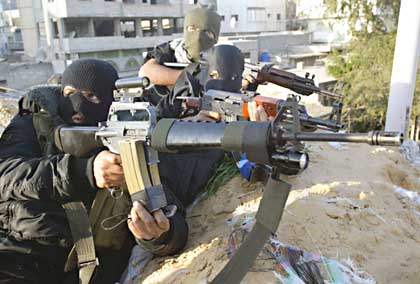
Well, following just some of the "highlights" of the latest developments in Gaza:
11 killed in Fatah-Hamas clashes (Yedioth Ahronoth)
Palestinians report Hamas gunmen attacked Presidential Guard's training camp near Karni crossing, with rising death toll. Eyewitnesses say many killed and injured, some by IDF fire. Fatah accuses Hamas of planning military coup
In the latest bout of infighting between Fatah and Hamas in Gaza on Tuesday, the death toll has risen to eleven, with Hamas apparently settling in for an exhaustive conflict.
Armed Hamas forced recently surrounded a Palestinian police center in northern Jabalia, while other armed Hamas forces barricaded themselves inside Gaza's Islamic University. Hamas officials warned that if the university is attacked, even "the house of (Palestinian Authority President Mahmoud Abbas) will not be safe."
Earlier in the day, Hamas gunmen attacked a Palestinian Presidential Guard's training camp near the Karni crossing. Eight people were killed and 20 were injured in the original attack. Another Palestinian officer who escaped toward the border fence was shot to death by IDF soldiers.
Hamas accused IDF soldiers of assisting the Presidential Guard officers. The officials said the Israeli army allowed a number of Fatah affiliated security officers to enter its territory to escape from a Hamas attacks. A Palestinian security official denied the report.
Fatah officials blamed both Hamas and the IDF for the incident, claiming that Hamas was planning a military coup in the Palestinian Authority.
The crossing, which is one of the Presidential Guard's main posts in the Gaza Strip and is also used as a Fatah training camp, was closed due to the exchanges of fire.
According to the reports, Hamas member attacked the post using mortar shells and then executed some of the Fatah members.
Three of shells landed on Israeli territory near Kibbutz Nahal Oz. There were no reports of injuries, but the shells caused slight damage.
Hamas members claimed that all the Palestinians killed in the incident were hit by an IDF shell. Army officials denied the accusation. Hamas said it would respond to the incident by firing Qassam rockets at Israel.
Hamas officials said that the attack was a response to the killing of Ibrahim Maniyeh, the commander of the organization's military wing in the Sajaiyah neighborhood located near the crossing.
Palestinians reported that all the men killed in the attack were members of the Palestinian Presidential Guard.
As for the Palestinian killed by IDF fire, the army reported that soldiers had spotted two suspicious Palestinians near the border fence, south of the Karni crossing. The force shot at them and hit them.
IDF sources confirmed that the two were apparently Palestinian police officers who fled the attacked post, but said that when the incident happened the troops suspected they were gunmen approaching the border fence.
The attack was carried out despite the great efforts exerted Monday night by Palestinian Prime Minister Ismail Haniyeh and Palestinian President Mahmoud Abbas to end the infighting between the rival Fatah and Hamas factions.
The attack proved once again that the Palestinian prime minister's had very limited control over his organization's military wing.
Due to the escalation in Gaza, universities in the Strip did not resume classes for the second day in a row. A Palestinian parliament session scheduled to take place Tuesday was cancelled.
The Karni crossing incident came after a long period of time in which the crossing had operated with almost no interruptions. The District Coordination Office (DCO) reported of a significant rise in the exports and imports of goods from and to Gaza, leading to a slight improvement in the Palestinian economy.
The IDF is looking into the clashes at the crossing. Security sources noted that Hamas was attempting to get Israel involved in the internal conflict by spreading testimonies that Israel allegedly helped Fatah.
The army will hold discussions on the future of the Karni crossing and will decide whether to reopen it on Wednesday. Military officials said that Hamas' takeover of posts located near the crossing could constitute a security risk.
http://www.ynetnews.com/articles/0,7340,L-3400140,00.html
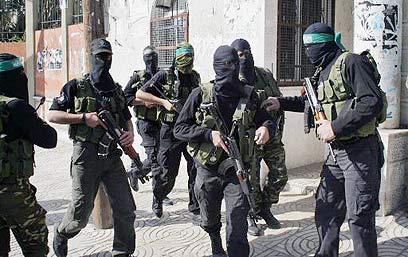
For more please read:
☞ Hamas kills eight in attack on Fatah jeep.. (Haaretz)
☞ Fatah claims Hamas ambush on camp (al-Jazeera)
☞ Mubarak to Palestinians: You have crossed the line (Ynet)
☞ Bloody infighting leaves Gaza a ghost town
BTW: "UNITY IS OUR WEAPON" AGAINST...(whatever)^^
Wednesday, 5.16 (update)
Of course also today "the beat goes on".. BTW, it seems that it's not enough when the rival factions are killing each other during battles, sometimes the survivors were/are just executed..
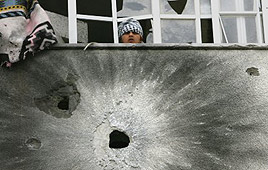
Anyway.. here the latest developments:
PA official: Abbas may announce state of emergency (12:15 CET)
Palestinian deputy-prime minister, Azzam Al-Ahmad, said Wednesday that Palestinian President Mahmoud Abbas may announce a state of emergency if clashes in the Gaza Strip continued. The Palestine Liberation Organization (PLO) Executive Committee is expected to meet within the hour to discuss the situation. Meanwhile, Committee Chairman Yasser Abed Rabbo, called on Gaza residents to rebel until Hamas militias are dismantled.
7 killed in Israeli air strike at Hamas building (13:05 CET)
Israeli army helicopters fired missiles Wednesday afternoon at a Hamas building in the southern Gaza Strip, killing seven members of the Islamic group and wounding 10 others. The army said the building situated in Rafah along the border with Egypt was used by Hamas to plan terror attacks
Abbas, Mashaal agree to end violence in Gaza (13:30 CET)
Palestinian President Mahmoud Abbas, and exiled Hamas politburo chief Khaled Mashaal, reached an agreement on Wednesday to stop the violence between the factions in the Gaza Strip, according to Palestinian Information Minister Dr. Mustafa Barghouti. Fourteen Fatah and Hamas members were killed in Gaza on Wednesday, raising the death toll in the city to 40. (AFP)
☞ Hamas mistakenly kills 5 of own fighters (13:35 CET)
Mortar shells fall near Abbas compound in Gaza (14:25 CET)
At least two mortar shells fell on Wednesday near the compound of Palestinian President Mahmoud Abbas in Gaza City, Palestinian sources said. Eyewitnesses said a handful of bystanders were lightly injured. Abbas, who resides in Ramallah, is expected to arrive in Gaza tomorrow in an attempt to ease tensions between his Fatah group and Hamas
Palestinians rally to end fighting, 8 wounded (15:00 CET)
Dozens of Gaza residents turned out for a rally on Wednesday to demand an end to factional fighting, only to be caught in crossfire that wounded eight of them.
“Just as we used to protect you from the occupation by acting as human shields, we have come to protect you from yourselves,” one protester shouted at gunmen, referring to instances when Palestinian civilians positioned themselves between militants and Israeli forces. (Reuters)
etc, etc...
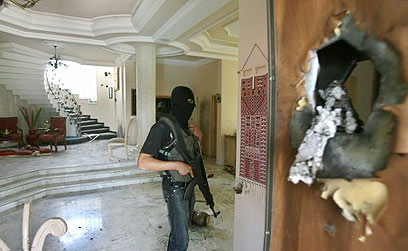
Read also:
☞ IAF hits Hamas Gaza HQ as 10 Qassam rockets hit Israel (Haaretz)
☞ At least 13 dead as Hamas-Fatah clashes rage in Gaza Strip
☞ Solution for PA anarchy (Yedioth Ahronoth)
Last Friday (5.12) Hankyoreh published following report about the daily hardship of street vendors especially in the area in and around Dongdaemun Stadium (*):
City’s plans mean vendors face another forced move
After being shifted into another district due to development, park plan threatens new home
"What do we do when the city fails to keep its pledge whenever its mayor is reshuffled?"
The face of Cha Jeong-ho, 79, was twisted in anger as he talked to the Hankyoreh. Cha sells small electronic gadgets such as electronic calculators and remote controls at a flea market around Seoul’s Dongdaemun Stadium.
"I came here because the city government promised it would build a world-renowned flea market here. But now the government tells me it is just going to bulldoze this area. Where will I go?"
Cha is not alone. The flea market he works in contains 894 vendors. All are afraid regarding their future after the city government informed them June last year that demolition of the area would begin from the end of this year.
Sohn Myeong-u, 51, who sells T-shirts at the flea market, said, "After the city announced the plan to demolish the market, the number of customers coming here dropped by a third."
Although the city government plans to demolish the market starting in November, it has not announced a solution regarding a new home for the vendors who operate their stores there.
For these vendors, the demolition moves represent yet another in a long line of broken promises from the Seoul government. This was not their original place of work: they were moved here from the Hwanghak-dong flea market after former Seoul city mayor Lee Myung-bak implemented a restoration project of the Cheonggye stream in 2003. At that time, the vendors believed the former mayor’s pledge to build a world-renowned flea market. However, the pledge changed shortly after incumbent mayor Oh Se-hoon took office in May last year, as one of Oh’s campaign promises was to build a park and a design center nearby Dongdaemun.
Oh’s words understandably drew protest from the area’s vendors. Since June last year, the city government has formed a body to seek a solution with five representatives of the vendors, but no agreement has been forged. In fact, the two sides have not met since April due to the government’s failure to call a meeting. Additionally, there was no public hearing or survey of vendors regarding the plans.
A Seoul government official said, "The region around Dongdaemun Stadium was a temporary space for vendors while the city was in the process of restoring Cheonggye Stream. After taking into consideration their situation as compared with that of other street vendors, we plan to map out rational measures," the official said, asking not to be named due to the sensitivity of the subject.
Moon Seung-guk, Seoul city’s official in charge of the project, said, "We are now in discussions with the vendors; therefore, we could delay the demolition by March of next year."
In the meantime, the Seoul city government announced on May 10 that it will select eight domestic and overseas architects to build the park around Dongdaemun Stadium. After receiving a draft design for the park on August 10, the government said it will announce a winner shortly thereafter, which means the vendors around Dongdaemun Stadium that will be displaced by the new park must quickly find a new home.
http://english.hani.co.kr/arti/english_edition/e_national/208806.html
* Well, that's the result of the creation of a "Clean, Attractive and Global City", declared by the Seoul Metropolitan Gov't.
And of course in this f.. "Clean, Attractive.. City" there is no place for street vendors, for the poor in general.
Actually since several years I followed this kind of "city development" and many times, since Nov. 2003 I wrote reports about the resistance of the affected people especially in the areas downtown Seoul, such as Jung-gu and Jongno-gu (but also in other areas, cities, such as Ilsan, Uijeongbu..)
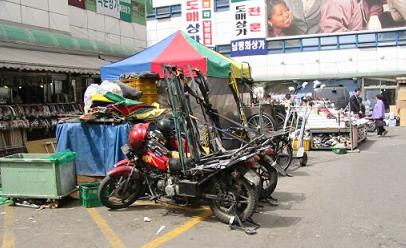
For more please read/watch following:
☞ RESTORATION MEANS DESTRUCTION
☞ Street Dealers.. Vanish As Seoul Seeks to Modernize (Yonhap, 2004.07)
☞ [청계천 노점상 생존권 사수 투쟁] 제1부 ("Struggle" video. VERRY IMPRESSIVE!!!)
☞ [청계천 노점상 생존권 사수 투쟁] 제2부 (Docu, interviews)
For more informations (in Korean) about the recent/current struggle of street vendors in Jung-gu (Cheonggyecheon/Dongdaemun..) please check out:
☞ 청계천 투쟁/전노련
Somehow related:
☞ 2004 StreetNetFestival 동대문운동장
Following story was one of last week's 'main' in'l 'news': "Hamas militants have enlisted the iconic Mickey Mouse to broadcast their message of Islamic dominion and armed resistance to their most impressionable audience -- little kids.

A giant black-and-white rodent -- named 'Farfour,' or 'butterfly,' but unmistakably a Mickey ripoff -- does his high-pitched preaching against the U.S. and Israel on a children's show run each Friday on Al-Aqsa TV, a station run by Hamas." (AFP, 5.08)
Well, watch some parts of the recent TV show here!
Following are some excerpts from some recent "shows":
Farfur: “We are setting with you the cornerstone for world leadership under Islamic leadership. Isn’t it so, Saraa’?”
Saraa’: “Yes, our beloved children.”
Farfur: “You must be careful regarding your prayer and to go to the mosque for all five [daily] prayers. I say, in the mosque and in the first rows, until we can lead the world.”
Saraa’: “We remind you that we, the great ones, started this program to lead this world. The nucleus, with the will of Allah, will be from here, from Palestine. We will carry the concern of this [Islamic] nation that awaits us.”
Farfur: “From Palestine, oh Saraa’, what do you mean? From Gaza, Jerusalem, Ramallah, or from all of Palestine?”
Saraa’: “Yes, from all of Palestine" [i.e., includes Israel –editors].
Farfur: “If so, my beloved young ones, with the will of Allah, we will lead the nation from here, from Palestine.”
Saraa’: “Our beloved children, many say that we had glory [in the past], and we had culture, and the Muslims had greatness and respect. But with the will of Allah, we, tomorrow’s pioneers, will restore the glory of this nation.”
Farfur: “Yes, we, tomorrow’s pioneers, will restore to this nation its glory, and we will liberate Al-Aqsa, with Allah’s will, and we will liberate Iraq, with Allah’s will, and we will liberate the Muslim countries, invaded by murderers.”
Saraa’: “Yes, they are children occupied by the Jews, but with the will of Allah, we will resist and protect against the Zionist occupation.”
Farfur: “Until we win, with the will of Allah, we will resist until we win.”
[Al-Aqsa TV, April 16, 2007]
* * *
Saraa’: "…We remind you that we will lead this world, and the center of the leadership, with the help of Allah, praise him, is from here, Palestine, and will burst out across the world…"
Girl: "What do you want to be when you grow up?"
Boy: "Doctor."
Saraa': "You see, Farfur, everyone is ambitious and wants to lead the world. You… want to lead the world, Ahmad?"
Ahmad: "Yes."
Saraa': "It's important…"
Farfur to the girl: "Fatima, you hear me? What do you say to the prisoners in the prisons of the oppressive invading Zionist occupation…?"
[Esraa' sings a song, Farfur is delighted until the words] "…we will surrender ourselves…"
Saraa': "Esraa', it's not a good song. Why?"
Esraa': "Because it has surrender."
Saraa: "We don’t surrender, we want to resist against the enemy, isn't it so, Farfur?… We want to resist against the enemy, and we don’t want to surrender."
[Farfur compares Abu Jahal, who was the most prominent enemy of Muhammad in Mecca, to Sharon]
Farfur: "Allah willing, this country, its children, its men, its women and its elderly – will win – we will win, brothers. We will win, Bush! We will win, Sharon! Ah, Sharon is dead. We will win, Mofaz. Mofaz left. We will win, Olmert, we will win Condoleezza … we will win."
Saraa': [Final words] "…I remind you that we are the ones who will carry the concerns of this [Islamic] nation, and we will lead this world, and I remind you that Al-Aqsa and the prisoners are a responsibility on our shoulders, and Allah will ask us on Resurrection Day what we gave for their sake."
[Al Aqsa TV, April 23, 2007]
For more about the issue:
☞ Hamas employs Mickey Mouse (Yedioth Ahronoth/IL)
☞ Hamas Mickey Mouse Teaches Jihad (Der Spiegel/D)
☞ Hamas' Mickey Mouse.. to teach.. Islamic supremacy (Palestine Media Watch)
☞ Hamas TV defies gov't request, airs anti-Israel children's show (Haaretz/IL)
Somehow (^^) related:
☞ Gaza: Fatah official's bodyguard killed in school event
☞ UN attacked for "spreading Christianity"?
Meanwhile, despite the USA, EU, some Arab regimes, parts of the PA and of course the Israeli gov't are talking nonsense about the "ME Peace", Hamas, IJ etc. and (at least) the IDF are preparing for the next round of war in/against Gaza:
☞ Ministers meet on steps to counter Gaza militants (Haaretz, 5.13)
☞ You'll return from Gaza in a coffin, Hamas warns Israel (Y. Ahronoth)
☞ Islamic Jihad says Qassam rockets to be improved
☞ Israel to continue assassinations (al-Jazeera)
And of course - surprise, surprise - the bloody power struggle between the Palestinian "resistance" organisations is still going on:
11 wounded in Fatah-Hamas gun battles in Gaza City
Palestinian medical officials reported that at least 11 people were wounded, four of them fatally, in exchanges of fire between Hamas and Fatah operatives in Gaza City Sunday. The violence erupted after two members of the al-Aqsa Martyrs' Brigades were killed, although Hamas denied any involvement in their deaths.
(5.13, 16:08 CET)
Two Hamas operatives were killed..
..in exchanges of fire between Hamas and Fatah members in Gaza Sunday. The two were killed after Fatah members opened fire towards a Hamas operative, in response to the killing of two al-Aqsa Martyrs' Brigades members earlier.
(5.13, 16:54 CET)
Following - in my opinion - very interesting, if not to say significantly ('cause it's complete without nationalist, pro-NK stuff) article has been published in yesterday's Hankyoreh:
How can a peace be achieved on the Korean Peninsula?
Building a permanent peace regime on the Korean peninsula is long-cherished dream of Koreans who underwent terrible sufferings and devastating damage during the Korean War which broke out in 1950. Permanent peace is considered to be the only way to avoid another war on the Korean peninsula. If war breaks out again, the consequences would be disastrous. The existence in Korea of a national consensus on the need for a solid peace framework, a consensus that supersedes political affiliations, is indisputable.
Even though more than five decades have passed since the Korean War ended, the two Koreas are still technically at war each other. Three countries signed the armistice; North Korea, the U.S. and China. South Korea did not join in. Then South Korea President Syngman Rhee refused to sign the document, arguing that an armistice would remove the chance to reunify Korea.
Since then, it is North Korea which has consistently been calling for negotiations for a peace treaty with the US. The main goal of North Korea's peace initiatives was eventual withdrawal of the U.S. forces from South Korea. North Korea perceived that the military presence of the U.S. in South Korea posed a serious threat. But North Korea's demands were simply rejected by the United States because North Korea insisted that South Korea be excluded from the peace treaty negotiations. North Korea argued that south Korea is not entitled to join peace negotiations because South Korea was not a signatory to the armistice. North Korea has not changed its stubborn position on who should be the principal participants in the peace talks.
When the four-party talks convened in 1994 to discuss North Korea's nuclear program, North Korea reiterated its position that South Korea shoud be excluded. As North Korea's nuclear disputes intensified, South Korea and the US reversed their position on peace talks. The two countries are very eager to embark on talks even though they attach preconditions for them. One precondition is North Korea's repudiation of nuclear weapons programs. Top leaders of the two countries emphasize that they are ready to start peace talks if North Korea would abandon its nuclear ambitions. The US links the denuclearization of North Korea to the peace agreement. On the other hand, South Korea was greatly anxious to reach a peace agreement as part of its efforts to avoid war on the Korean peninsula and to pursue stability and co-prosperity.
When tensions over North Korea's nuclear program escalated, support for peace regime gained momentum among decision-making circles in both South Korea and the United States. The peace mechanism is considered useful in diffusing tensions on the Korean peninsula. South Korean leaders seemed to have the view that North Korea's nuclear disputes could be resolved only in the context of a comprehensive peace framework. From this viewpoint, the denuclearization of the Korean peninsula could be realized only through establishment of the permanent peace mechanism.
In the United States, officials at State Department and the White House began to pay attention to the effectiveness of the peace regime on the Korean peninsula. They realized that the peace regime could serve as another multilateral forum to persuade North Korea to give up the nuclear weapons program. Philip Zelikow, foreign policy consultant to Secretary of State Condoleeza Rice is known to play a leading role in conceptualizing the peace regime. Zelikow reportedly advised Secretary Rice to push ahead with the peace formula.
It was again this backdrop that South Korean President Roh Moo-hyun and US President George W. Bush agreed in a summit held Nov 17 2005 in Gyeongju, a city of southeastern Korea, "to make common efforts to develop a regional multilateral dialogue and a cooperation mechanism so as to jointly respond to regional security issues."
The two leaders reaffirmed their commitment to the peace regime when they met on the sidelines of the APEC summit in Hanoi in November 2006, a month after North Korea conducted a nuclear test on October 9, 2006. At the meeting, Bush disclosed that he has the intention to sign an agreement officially declaring the end of the Korean War together with South Korean President Roh and North Korean leader Kim Jong-il.
Since then, the peace regime has gained momentum. In the six-party talks, agreement was reached twice (in September 19, 2005 Joint Statement and in the February 13, 2007 Agreement) to set up a separate forum to discuss a permanent peace mechanism on the Korean peninsula.
At this point, the separate peace forum remains to be launched due to the tug-of-war over North Korean money frozen at the BDA account in Macau. When the follow-up working group negotiations start, the peace forum will get started.
Before moving on to how to build a permanent peace regime on the Korean peninsula, let us talk about what major source of tensions and hostilities which could imperil the peace on the Korean peninsula?
Fundamentally, the division of the Korean peninsula after World War II is often cited as a primary source of tensions and hostilities on the Korean peninsula. Two Koreas fought each other in the Korean War. For a long time, North Korea's military threat has been considered as a major factor in tensions. In this context, reunification of the divided Koreas would lead to peace on the Korean peninsula.
However, the security situation in Korea underwent a sharp change after the end of Cold War, symbolized by the dramatic collapse of the Soviet Union and a number of East European communist countries. Since then, the threat from the isolated and poor North Korea has diminished significantly. Even though North Korea now posseses nuclear weapons (or devices), few South Koreans feel the North is a serious threat.
The North is widely believed to be incapable of sustaining warfare even though it strikes first against South Korea. North Korea's long-time ally, China, is unlikely to support North Korea's possible war against South Korea. In view of its poor economic performance and sheer diplomatic isolation, North Korea is unlikely to turn to military adventurism. Launching war on South Korea would be military suicide.
Rather, North Korea seemes to worry about the possible military attacks by the United States since President George W. Bush took power in 2001. In particular, North Korea appeared to feel a serious threat from the U.S. since President Bush branded it a member of the "Axis of Evil" in his 2002 State of the Union address. As a matter of fact, the U.S. did not rule out the possibility of a "preemptive strike" against North Korea as part of its efforts to remove nuclear facilities in North Korea. Top leaders of the US made it public that "all options are on the table" to resolve the North Korean nuclear cirsis. In this sense, hostile relations between the US and North Korea constituted a major source of deteriorating instability and growing tensions in the Korean peninsula.
The primary motivation behind the Bush administration's hostile policy toward North Korea during its first term rested with its repudiation of Clinton's engagement policy toward North Korea. President Bush's North Korea policy, which was dominated by hawkish key figures like Vice President Dick Cheney and Secretary of Defense Donald Rumsfeld, was characterized as ABC(Anything But Clinton). The Bush administration had been pursuing eventual regime change of North Korea until it finally decided to start one-on-one negotiations with North Korea in Berlin in January of this year.
Tensions culminated in North Korea's nuclear test which was conducted on Oct 9, 2006. To sum up, hostilities and distrust between North Korea and the US combined to escalate tension in the Korean peninsula. There is no doubt that North Korea's nuclear weapons are escalating tensions in the Korean peninsula and East Asian region. Japan may feel tempted to develop nuclear arms to have a deterrent against North Korean nuclear weapons. Taiwan will continue to observe what's happening with the North's nuclear program. These scenarios are the worst ones China could possibly imagine. Sometime in the future, South Korea may try to possess nuclear weapons as well. A nuclear arms race will be inevitable if North Korean nuclear weapons are left unchecked.
Another source of tension in the Korean peninsula is the Sino-Japan rivalry in East Asia. Mindful of rapid rise of China's influence in the region, Japan has been building up its military power. Japan may justify its military buildup as self-defense against North Korea's nuclear weapons and long-range missiles. Japan has been exploiting North Korea's nuclear threat as a pretext for rearming itself as well as pushing for a revision of Article 9 of its constitutional to allow it the right to wage war and maintain legitimately armed forces. But it is widely believed that Japan's military buildup is aimed at its archrival China.
How can peace be achieved on the Korean peninsula? Considering the fact that hostile relations between North Korea and the US constitute a major obstacle to the peace in the Korean peninsula, normalization between the two countries would be indispensable. The North Korean nuclear crisis grew critical as the Bush Administration engaged in explicitly hostile posture against North Korea.
The Atlantic Council peace regime report released on April 13 this year deserves attention. The report is credited with a comprehensive approach to the blueprint for the peace framework. It includes five major points for the peace formula.
First, the report calls on the Bush administration to agree to a "denuclearization agreement." Second is to replace the armistice of 1953 with a "four-party" agreement between the two Koreas, the US and China. Third is for the US to sign a bilateral agreement with Pyongyang to settle outstanding legal and political issues. Fourth is to negotiate a trilateral agreement with both Koreas for the sake of confidence-building measures between the military forces, as a step toward the four-party agreement. Fifth is to work on establishing a multilateral organization for security cooperation in Northeast Asia modeled after Organization of Security and Cooperation in Europe.
The report is the first of its kind to present detailed and concrete steps to reach a full-fledged peace framework on the Korean peninsula rather than focusing entirely on the North Korean nuclear issue. In the past, former President Kim Dae-jung also proposed the peace formula shortly after he took office in 1998. His main concept was for both Koreas to sign a peace treaty with full supports from the U.S. and China.
Both South and North Korea have been seeking to diffuse tension and achieve national reconciliations. This effort dates back to 1972 when the two sides declared historic 'July 4 Declaration' which set out broad principles of Korean reunification. The three main pillars of the Declaration were national self-determination, peace, national solidarity.
The July 4 declaration came in the wake of the so-called Nixon shock. President Nixon's surprise visit to Beijing and the historic Shanghai Communique which paved the way for normalization between the U.S. and China shook the whole world. In particular, South and North Korean leaders were greatly astonished by detente and subsequent cross-recognitions between the US and China.
From this viewpoint, the July 4th Declaration was a response to the sudden Sino-US detente. However, inter-Korea detente did not last long. Each side exploited it as a chance to strengthen autocratic rule in each country. North Korean leader Kim Il-sung was able to become ruler for life. In the South, Park Chung-hee established himself the unchallenged dictator with the Yushin Constitution, allowing himself limitless power. Unfortunately, the first inter-Korea detente led to more harsh authoritarian rule in each side.
About two decades later, South and North Korea reached a historic peace pact known as "Basic Agreement" on December 13, 1991, which became effective in February 1992. It called for both governments to endeavor together to transform the present state of armistice into a solid peace between the two sides. Unlike the 1972 pact, the Basic Agreement outlined a number of security-related CBMs (confidence-building measures) as well as various measures concerning North-South reconciliation, non-aggression, exchange of people and economic cooperation. Together with the Basic Agreement, two Koreas created the "Declaration on the Denuclearization of the Korean Peninsula." It forbade both sides to test, manufacture, produce, receive, possess, store, deploy, or use nuclear weapons and forbade the possession of nuclear reprocessing and uranium enrichment facilities. A procedure for inter-Korean inspection was to be organized and a North-South Joint Nuclear Control Commission (JNCC) was mandated with verification of the denuclearization of the peninsula.
How to build a permanent peace regime on the Korean Peninsula? What is a peace regime? Is it simply to end the state of war officially by replacing 1953 armistice with a peace agreement(treaty)? A peace agreement alone would not end hostile relations and possibilities of war. The peace regime should involve a whole set of country-to-country and people-to-people relationships, by which peaceful coexistence and co-prosperity could be achieved on the Korean peninsula.
Both South and North Koreas have already produced a significant peace mechanism 15 years ago, 1992, widely known as Basic Agreement. The Basic Agreement contains almost everything when it comes to peace frameworks on the Korean peninsula. The basic spirit is reconciliation, peace and exchanges. It deserved to be called as textbook of Korean peace mechanism.
However, it lacks one crucial element. It did not secure full support from key stakeholder countries which affect the security of the Korean peninsula, that is the U.S. and China. The two countries were entangled in the Korean War and fought against each other. As a matter of fact, the Basic Agreement was invalidated when the first North Korean nuclear crisis surfaced in 1994. The first North Korean nuclear crisis could be settled down when the U.S. and North Korea reached the Agreed Framework in 1995. However, the Agreed Framework was also nullified when the Bush Administration killed it in 2002, alleging that North Korea had not live up to the Agreed Framework by seeking to operate covert highly enriched uranium (HEU) program. The foiled Agreed Framework left a valuable lesson: peace frameworks would work only when revelent countries like the U.S. and China are involved as principal partners.
What shoud be done for a permanent peace on the Korean peninsula? As many experts and scholars point out, it is no doubt that improved ties between the U.S. and North Korea would be a first step toward the full-fledged peace regime on the Korean peninsula. In this context, the peace mechanism would require "grand bargain" package.
Measures that would be included in the package are:
1. To replace the 1953 war armistice with a peace treaty (or peace agreement). The principal partners would be the two Koreas, the U.S. and China.
2. To normalize relations between North Korea and the U.S. Hostile relations between the two countries have been a major source of tensions and instability on the Korean peninsula.
3. To achieve nuclear disarmament on the Korean peninsula. The first step would be North Korea's abandonment of nuclear programs.
4. To carry out confidence-building measures such as redeployment of forwardly deployed ground forces along the Military Demarcation Line which divides South and North Korea. Reduction of conventional forces are also followed as part of confidence-building measures.
5.To set up a multilateral security and cooperation organization in Northeast Asia.
6.To build a Northeast Asia Nuclear-Free Zone.
7.To establish an energy-cooperation mechanism under which Russia's natural gas is supplied to both Koreas, China and Japan through pipelines to be built to connect these countries.
In the context of Northeast Asia's regional security, a multilateral security organization and a Nuclear-free Zone are vital. In view of the fact that regional security could not come automatically even when North Korea dismantles its nuclear facilities fully.
What's needed to take place is a new approach to a permanent peace framework for the Korean peninsula as well as regional stability in Northeast Asia. The two goals cannot be separated. In particular, the economy of Northeast Asian countries are highly interdependent. The security of the region is also closely linked as well.
For its part, North Korea needs to change. As long as the so-called "military-first" ("Songun") structure of North Korea remains unchanged, it would be highly difficult, if not impossible, for North Korea to give up the nuclear weapons it might have produced.
Militaries always tend to maintain tension and military confrontation. North Korean leaders should realize that the time when military power alone is enough for defense is gone. History shows that military power cannot guarantee its survival. It should adapt to the global trend, which calls for a more open society and higher standards of human rights.
http://english.hani.co.kr/arti/english_edition/e_editorial/208361.html
Somehow(^^) related:
☞ Two Koreas agree on rail test, tension-reducing measures (Yonhap, 5.11)
☞ Two Koreas agree on train crossing, but just this once (JoongAng Ilbo)
☞ South Korea, US Differ Over Peace Treaty Timeline (Korea Times)
Well, yesterday's Chosun Ilbo (yeah, the reactionary S.K. daily!!^^) has been asking:
Why Are the Anti-FTA Protesters so Quiet?
On June 3 last year, three days before the first round of Korea-U.S. free trade negotiations opened, 1,300 anti-FTA protesters held a rally at the Jongmyo Shrine in downtown Seoul. Some 40 anti-FTA demonstrators went to the U.S. to oppose the trade talks, waving banners and took to the streets. Eleven months later, Korea started the first round of free trade talks with the EU on Monday. But there were no big anti-FTA protests in Seoul during the negotiating period. About 20 anti-FTA protesters gathered and called for the cancellation of the trade talks in front of the Shilla Hotel, the negotiating venue, on Monday morning, but that was all. Seoul Metropolitan Police said no anti-FTA rallies were reported.
Anti-FTA protestors just held press conferences and issued statement. Even the notorious lawmaker Chun Jung-bae, who staged a 25-day hunger strike against the trade treaty with the U.S., welcomed trade talks saying an FTA with the European bloc will be in Korea’s interest. Of course, it is welcome that anti-FTA protesters express their opinions in a reasonable way such as a press conference rather than massive rallies. Still, the question remains: what made them change their attitude?
Despite differences in detail, trade talks are trade talks and will require Korea to reduce tariffs and open its market. Indeed, an FTA with the EU could have a bigger impact on the Korean economy than one with the U.S., since the EU’s average tariff rate is higher than the U.S.’ On my way to the Shilla Hotel to cover the talks, my taxi driver said, “Why are they so quiet this time? They were noisy when trade talks with the U.S. were going on.” Many people must have the same question. Did they in fact just oppose a trade pact with the U.S. due to anti-American sentiment?
http://english.chosun.com/w21data/html/news/200705/200705090025.html
Related:
☞ S.Korea launches free trade talks with EU (VoP)
☞ Korea, EU wrap up first FTA talks (Korea Herald)
Germany: Wave of Repression
Against Anti-G8 Structures
Today since the early morning naerly 1000 police officers, including anti-terror units, were/are raiding offices and private houses of anti-G8 activists. Especially in Berlin and Hamburg the Federal Criminal Agency (BKA) is searching for "evidence" against a "terrorist organisation" with the "aim of preparing militant attacks against the G8-Summit" next month in Heiligendamm (north-east Germany).
Alone in Berlin at least six offices/social centers and several privat houses were raided..
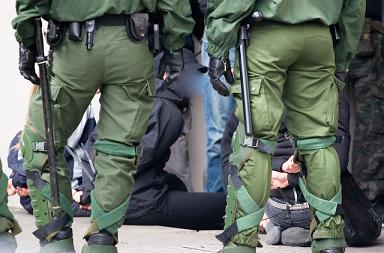
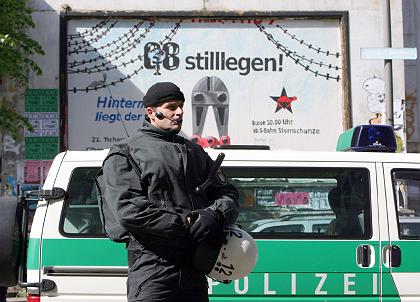
Well, actually the entire "operation" is just aimed to intimidate/oppress the entire anti-G8 movement in Germany.
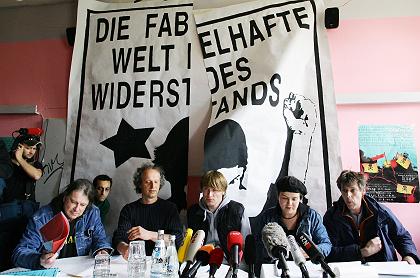
Press release:
Since Wednesday (May 9, 2007) morning 8 am a wave of searches is taking places against left structures throughout Germany. Targeted are social projects and private persons that are organizing against the coming G8 summit - or suspected to do so.
In Berlin at least seven flats and office spaces are being searched, amongst which two offices in Bethanien, a social centre in Kreuzberg, Berlin, and the Fusion shop in the same district. The latter is a space used by an antifascist organization and the Interventionist Left. Moreover, a bookshop in Mehringhof and the office spaces of several alternative media projects in Lausitzer Straße have been searched.
The criminal investigation police was putting special attention on the alternative Internet server so36.net. Many left and alternative projects have their websites, mailing lists and mail adresses hosted there. This way, the communication structue of the anti-G8 movement is hit on a sensibel point.
In Hamburg the repression is aimed against the social centre "Rote Flora" and diverse housing projects. Also in the surrounding of Berlin searches are taking place. And there are first reports about searches in the city of Bremen.
The orders for the searches are based on § 129a: "Formation of a terrorist association with the aim to stop the G8 summit". The random selection out of many left housing and infrastructural projects makes clear that the investigation is used as an excuse in order to weaken the mobilization against the G8. "Probably diverse cases of property damage serve as an excuse for these investigations", so the impression of the Campinski Press Group. One of these cases occured at the Kempinski Hotel, where the G8 summit is going to take place. The hotel was targeted with paint balls some months ago.
The context of a §129a investigation are instrumentalized in order to gather data about the protest movement. Besides, such measures have, most likely intended, intimdating effects. Only 2% of all $129a investigations result in sentencing.
However: "Who invites the G8 summit, also invites the protest against it", explains Hanne Jobst of the Berlin Bethanien office. "All attempts to criminalize this movement will not prevent us from exposing worldwide inequalities during the G8 summit."
The repressive acts of the criminal investigation police are not entirely surprising. The left and radical left resistance against the G8 has reached an uncontrollable level for the police. "So far, the police only tried to split the resistance in the public media through hallucinating about an army of 'anarchists'. Now they will try to sabotage the organizational structures", Jobst explains further.
"It is noteworthy that the searchces are targeted agaist all those parts of the resistance that refuse to direct claims to the G8, because they refuse the G8 in general as an illegitimate institution", explains a spokesperson of the Gipfelsoli Info Group.
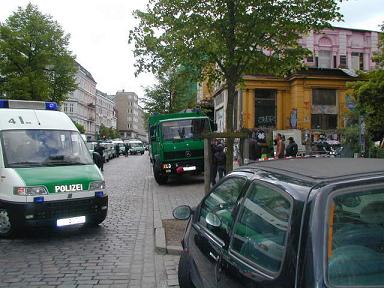
☞ Police Raids against G8 Mobilisation in Germany (int'l IMC)
☞ Police raid G8 'terror attackers' (CNN/Reuters)
☞ Germany Raids Leftist 'Terrorists' Ahead of G-8 Summit (Der Spiegel)
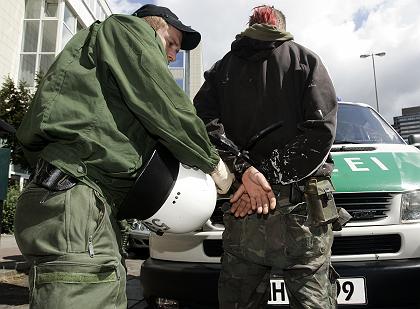
Related articles/links:
☞ THE APPROACHING G-8 SUMMIT (Der Spiegel, Germany)
☞ Uneasy echoes of Berlin in G8 wall (Guardian)
☞ G8 관련 자료
For more informations:
About two weeks ago Asia Times (亞洲時報) published following - in my opinion - interesting article:
Why Vietnam loves and hates China
For more than 2,000 years, Vietnam's development as a nation has been marked by one fixed and immutable factor - the proximity of China. The relationship between the two countries is in many ways a family affair, with all the closeness of shared values and bitterness of close rivalries.
No country in Southeast Asia is culturally closer to China than Vietnam, and no other country in the region has spent so long fending off Chinese domination, often at a terrible cost in lives, economic development and political compromise.
China has been Vietnam's blessing and Vietnam's curse. It remains an intrusive cultural godfather, the giant to the north that is "always there". Almost a thousand years of Chinese occupation, between the Han conquest of Nam Viet in the 2nd century BC and the reassertion of Vietnamese independence as Dai Viet in AD 967, marked the Vietnamese so deeply that they became, in effect, an outpost of Chinese civilization in Southeast Asia...
Please read the full article here!
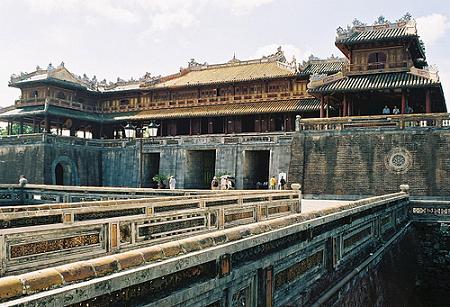
Citadel Gate, The Imperial City in Hue/Vietnam

Beijing, Meridian Gate, the front entrance
to the Forbidden City (Imperial Palace)
France: The Night After the Election
Yesterday around 53 per cent of the voters elected Sarkozy as the next president of the republic. But it seems that - surprise, surprise (^^) - not everyone was/is happy with the result..
Like in Paris, where thousands of mainly young people took the streets, also in other French cities such as Lyon, Tolouse, Marseille etc. large untits of the riot cops were contfronted with angry protestors.

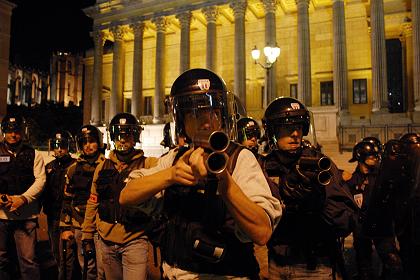
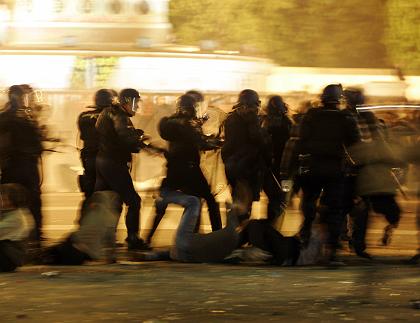
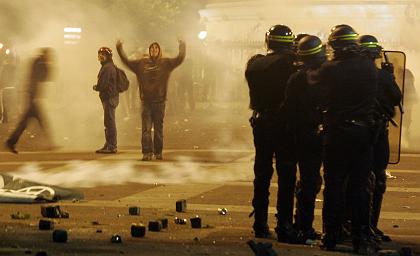
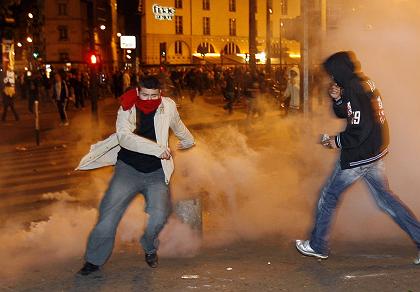
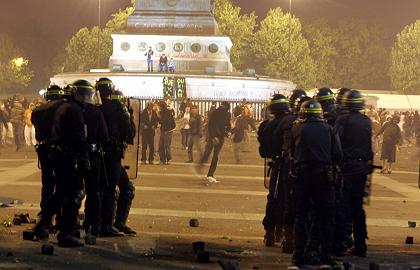
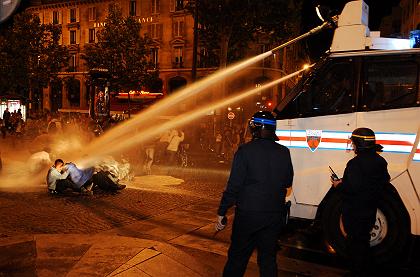




Related stuff:
☞ Cheering crowds hail Sarkozy's triumph (Guardian/GB, 5.07)
☞ THE TRIUMPH OF THE CONSERVATIVES (Der Spiegel/Germany, 5.07)
☞ Unions fire first shots in battle with Sarkozy (Guardian)
덧글 목록
관리 메뉴
본문
hey Chr. Do these links include your original reports from back in the day that you posted on the old ETU website? Anyway to get those?J
부가 정보